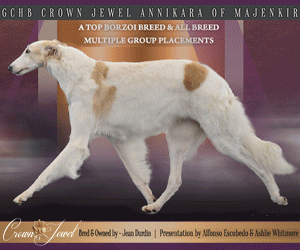The 7 Year Itch · Part 2
by Dr. Quentin N. La Ham
From the archives of The Canine Chronicle, June, 1992
PART 2
Why, regardless of the breed in question, do so many judges adopt the position of ‘first pick the type you like and then pick the best mover from among them?’ I do not hesitate to suggest that in many cases the reverse would be preferable if the best interest of the breed is at stake and it should so be. Why not pick your best movers first, if indeed the final test of conformation is in the movement of the dog, and then find the best types among them? The outcome can be very rewarding.
Now to some cases. Look what happened to the Rough Collie and, to a lesser extent, the Shetland Sheepdog when head and coat became more important than what is inside the skull and under the coat. This is not just my view. Longstanding and highly regarded breeder-judges have openly lamented the lack of a significant number of good specimens in our country. Is it good breed type when an animal only looks good but is so poorly structured that he could not, if called upon, perform his historical duties? Too often a truly good dog loses to an inferior one because of a light eye or a less than ideal ear placement. Some of these dark-eyed beauties might well have serious structural genetic defects which can have a detrimental effect upon the breed.
“Conformation means ‘to conform to the breed standard’. In almost the same breath we are told that the standard is open to interpretation.”
In Boxers, I find two statements often expressed dependent upon the year and the particular dog currently being campaigned. If the dog has a good head and far less as good a body, I am reminded that the Boxer is a “head breed”. If, by chance, sometime later the handler has a different dog with a less than ideal head, the story changes and I am reminded that “it takes more than a head to be a good Boxer!” Fortunately, in some the twain does meet but a head on a poor body too often beats a better dog. Herein lies the truth. True type is both. We call it CONFORMATION.
Conformation means ‘to conform to the breed standard’. In almost the same breath we are told that the standard is open to interpretation. This may well be true, but at the same time it is a chink in the armor! I can go along with interpretation up to a point. For example, there are infra-types as far as heads are concerned in most breeds, so what one considers to be ideal another may be heard to say “that’s not my preferred head” or may even go further and state “that’s a nice dog but not my type!” So, it is possible and indeed true that in many breeds–less so as previously stated in most Terriers–where the breeds do not undergo as rapid a metamorphosis as in others, that one refers to different types. Were that not so, how come in days gone by certain kennels were renowned for their specific breed type. Today, just to mention a few that are recognized by the type produced are Julia Gasow for English Springer Spaniels, Pat Craige for Norwegian Elkhounds, and Sylvia Hammerstrom for Giant & Miniature Schnauzers. They may have their detractors, as most successful persons do, but in all cases they knew and still know what they wish to achieve, and they have devoted much of their energies and resources to attain their goal.
So, type is to some degree variable and subject to subjective judgement, but it seems to me that if breed standards have any meaning there are certain inviolates that we have no right as breeders and judges to rationalize away.
Stay tuned for Part 3 on Sunday, May 10, 2020 …
If you missed part 1 of The 7 Year Itch click here
Short URL: https://caninechronicle.com/?p=183486
Comments are closed













